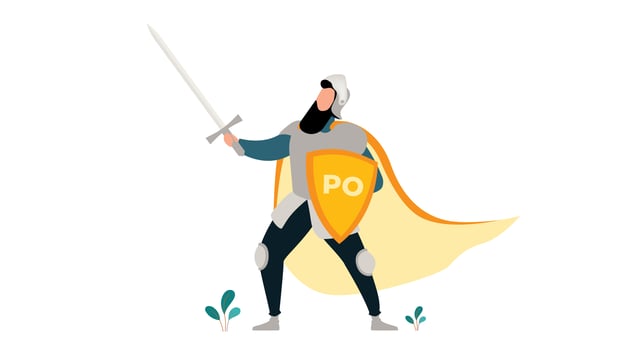In Agile product development teams, the Product Owner is responsible for representing the customer and stakeholders, and for prioritizing the team’s tasks.
This one person collects information from various sources, and has the relevant discussions to make decisions on:
- what is important
- what should be done
- what should not be done
In addition, the Product Owner ensures that the team has defined, important tasks to work on at all times.
Getting the most out of a big investment
“The Product Owner is responsible for ensuring that the team’s work is as valuable as possible for the organization.”
The Product Owner is responsible for ensuring that the team’s work is as valuable as possible for the organization. Sounds like an important job, doesn’t it?
Besides, for many companies, product development is a big investment. The salaries, computers, workstations, development and testing environments can add up to a fortune. The Product Owner is responsible for maximizing the profit of these investments in both the short and the long run while avoiding, in all circumstances, overburdened employees and burnouts. This way, the future will be secured.
A good Product Owner increases the productivity of the product development team manifold. A less good one can do the exact opposite. So neglecting the role of the Product Owner can be really hazardous for your organization.
A stress-free team brings you maximum return
Without an effective Product Owner, the team receives all the requests from the entire organization, and from the customers too. How are they able to decide what requests to serve? If there is no Product Owner, the team will try to serve all requests it receives. This will seriously overload the team, and makes them work as fast as possible.
This will lead to
- Increased stress levels
- Working as fast as possible, cutting corners in quality
- No regard for future-proofing the solution
- No refactoring - the new requests are implemented fast, without considering elegance of design
In short - without a Product Owner, the team resorts to “serve who shouts the loudest” and “try to do everything” approaches. Does it sound like something that will lead to maximizing the value that the team generates?
The Product Owner ensures that the team works on the most important things, and can work relatively stress free. This ensures better quality, future-proof implementation, and the best possible optimization of resource usage.
Doing It on the side can be dangerous
Of course, the role of the Product Owner can be taken on by, for example, roles like:
- the product manager
- the project manager
- product development manager
More and more often, though, companies realize that maximizing the value of the team’s work is so important that one person should dedicate their working time entirely to this purpose.
A full-time Product Owner is guaranteed to improve the team’s operation and clarify the backlog. This way, product development will waste less effort and you will get more out of the team with less stress.
Finding the right Product Owner - a list of their responsibilities:
If there is one golden purpose of this blog post, it is to provide you with a list of the Product Owner’s tasks. This will help you set the expectations and write a job advertisement that finds the Product Owner that is right for your organization.
If you need to, you can also use it to open your management’s eyes. Upon reading it, do they still think dedicated Product Owners are unnecessary?
Responsibilities of the Product Owner:
- Daily work in the Scrum/product development team
- Participating in most daily Scrum meetings
- Participating in retrospectives, demos, and Sprint Review meetings
- Approving the releases and Sprint artifact
- Answering the team’s daily questions, being present
- Product/team backlog
- Keeping the backlog in the right order according to priorities
- Preparing the prioritized backlog items with the team so that the team can start working on them
- Arranging regular backlog grooming sessions
- Arranging Sprint planning meetings and other planning sessions to improve the backlog (i.e. Sprint pre-planning sessions)
- Stakeholder communication
- Determining the needs of stakeholders
- Keeping the release schedule
- Understanding the velocity of the team
- Giving progress reports to stakeholders
- Organizing necessary demos and pilots to receive feedback from relevant parties
- Maintaining customer contacts and customer understanding
- Regularly contacting customers or other people who can directly contact the customer
- Organizing customer presentations, demos, and other meetings to collect feedback on the product, future plans, and the customer’s problems and needs
- Defining a good customer experience together with product management
- Managing errors
- Ensuring the right order of priorities of errors
- Determining what to fix for which release
- Ensuring that problems are clearly defined so that they can be resolved more efficiently
- Roadmapping and vision
- Long-term plans together with the product manager
- Release plans
- Product vision and visions for each release
- Scrum Sprint goals
- Coordinating tasks
- Participating in analyzing dependencies between teams and making sure the backlog is prioritized accordingly
- Making sure, possibly together with project management, that the work of sales, marketing, and customer support supports the release
- Learning and maintaining a positive atmosphere
- Contributing to a positive team atmosphere
- Understanding that positivity enhances results and creativity, coaching the other parts of the organization to help them realize this
- Making sure that the team improves their work
How does this list look to you?
Does it look like something that can be achieved in a few hours every week along with your own tasks? Or does it look like it could be a full-time job for someone?
Quite a few of our customers have chosen the latter!
Published: Mar 8, 2022
Updated: Aug 2, 2022


